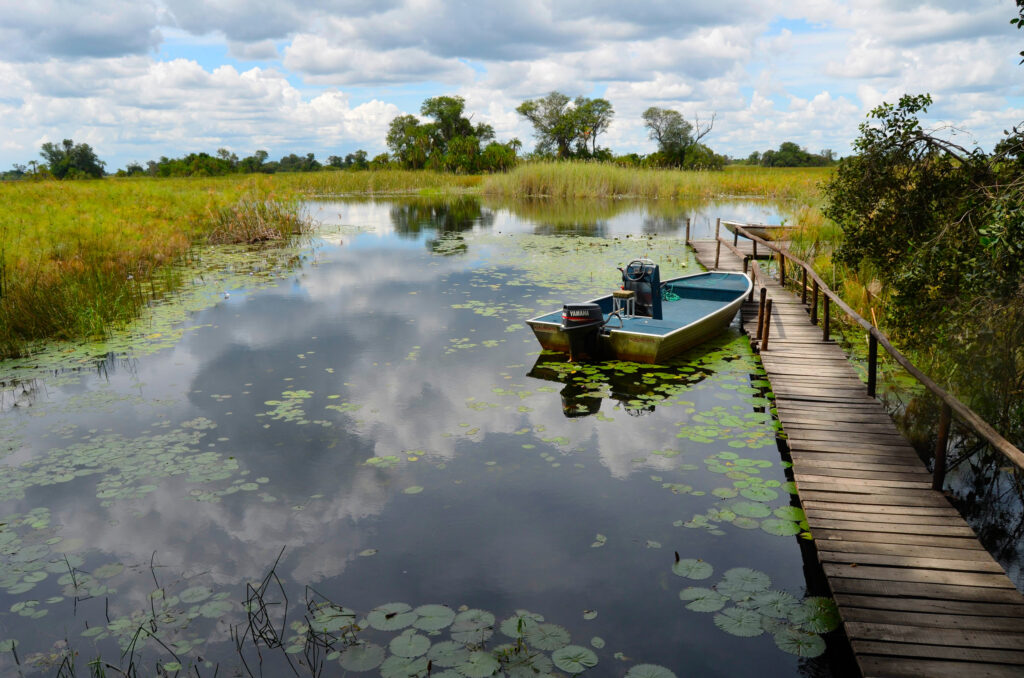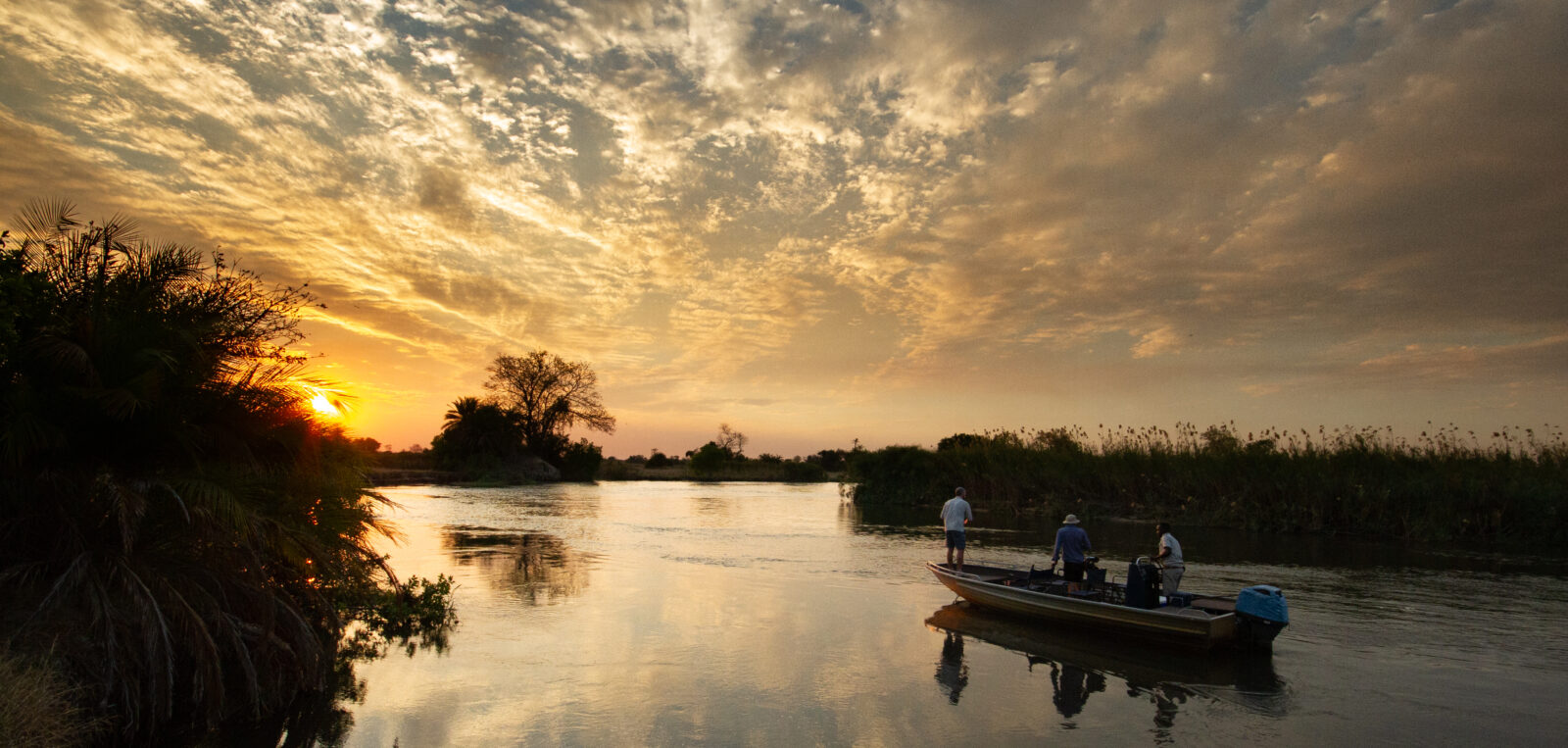Flyfishing for Okavango River Tigerfish
– Story by Gavin Harvey, a preview of his story in The Sporting Life –
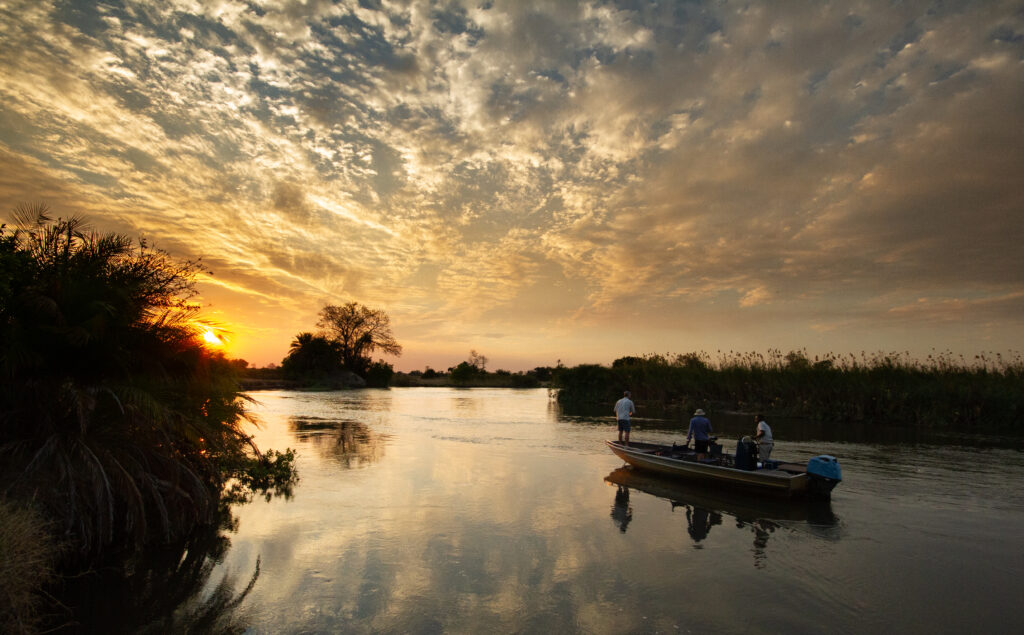
It is easy to lose yourself in the bends and twists of an unfamiliar delta river network. This one, in the northern panhandle of the Okavango Delta, threads for miles through a flat plain, hemmed in by thick stands of tall papyrus reeds on all sides, domed above by the cloudless blue African sky. The flat aluminum skiff buzzes atop the moving river and slaloms from one channel to another, all featuring the same tea-tinted water, the same pale brown and green banks of papyrus, the same blue sky above.
I’m nudged out of languidness when the outboard motor throttles back and the skiff slows. Our guide is System, who adopted his nickname for Western visitors who would struggle with pronouncing his given, Botswanan tribal name. My hunter’s senses flicker on as System listens to the delta. A faint chatter is brought to us in the breeze.
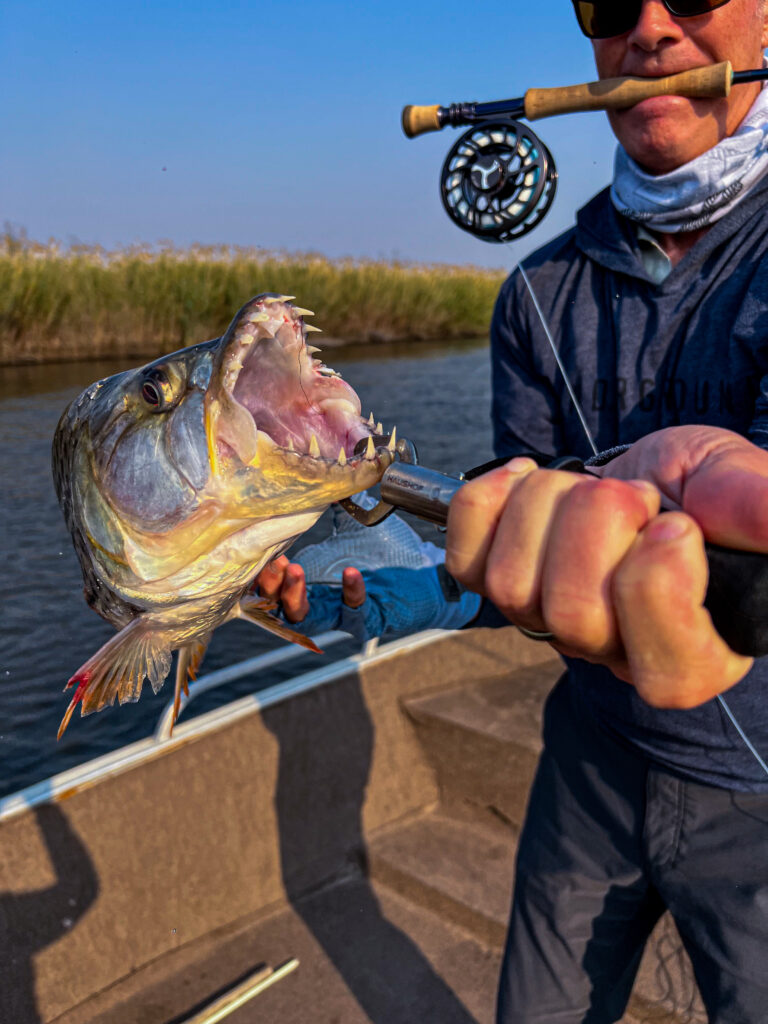
“There,” says System.
He motors the skiff down river, around one oxbow and another, where the chatter grows clearer and we come upon the birds. Our brown and green palette is now splattered with snow white as agitated egrets jockey for position at the river’s edge for a hundred yards. Scores of Great, Intermediate, Little, Cattle and Slaty egrets hop and flap and flutter on the tufted tops of the papyrus, on stumps, driftwood and any perch that will hold them. They chase away, and are chased off by rivals crowding the thicket. Squawking and bickering, the egrets are joined by kingfishers, cormorants, darters, ibis, storks, herons, and fish eagles, all staging for what is to come.
System motors us to the end of the avian gauntlet and anchors, about 20 yards from the bank. My heart rate rising, I step to the bow platform with my fly rod in one hand, black and red Andino Deceiver in the other. My wife Jonnie stands ready as well, midship, with her spin rod baited with a Rapala Magnum. The birds become increasingly feverish, shoving and taunting each other, their squawks becoming a cacophony of shrieks, whistles and wails. Even the fish eagles are bawling.
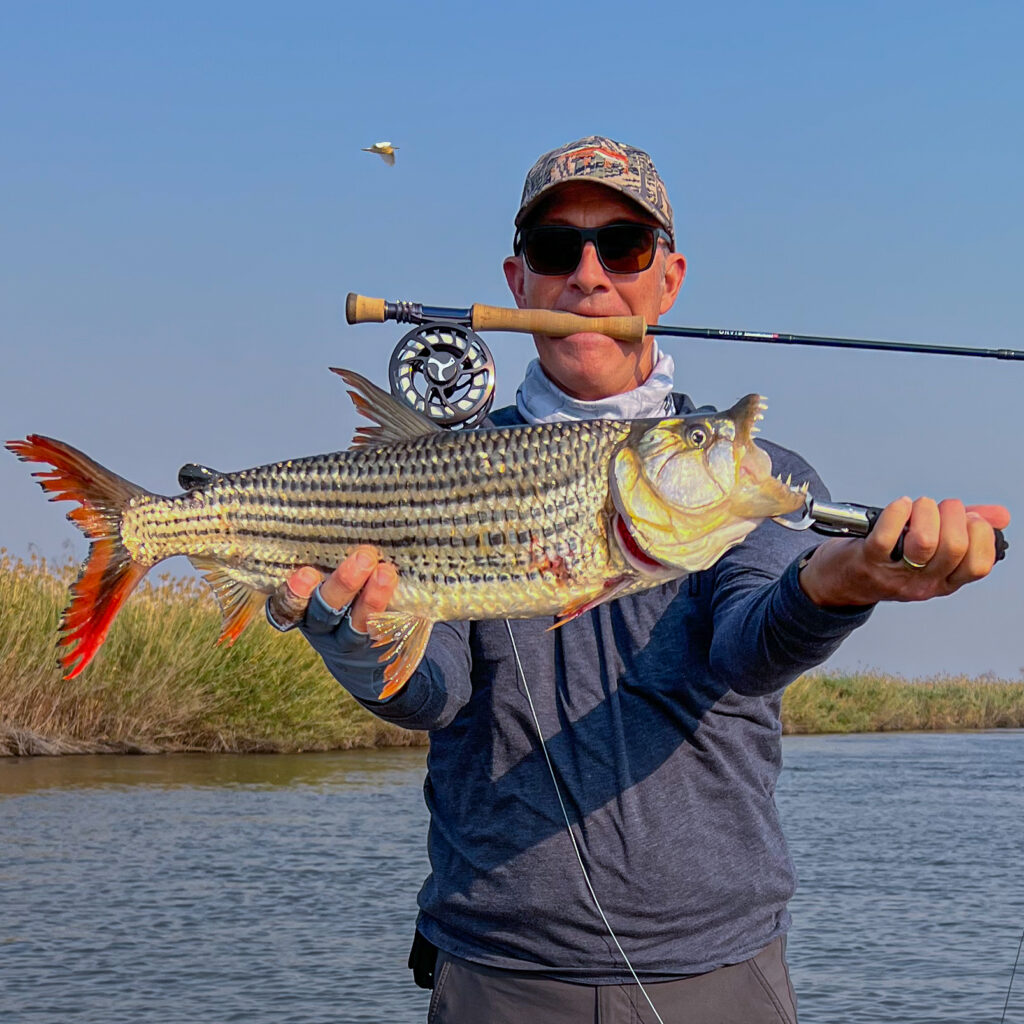
The keening din peaks as we look downstream and see the shoreline water riffle, then rumble as if a narrow, seismic murmur is slowly churning toward us. The papyrus thicket sways and shakes 10 yards deep, the reeds pop and snap as if a ghost army is marching through it. We hear splashing, slapping and popping water as the murmur advances upstream through the tangle.
“They are coming”, says System.
They are the barbel, the sharp-tooth and blunt-tooth catfish species that populate the Okavango River and Delta. With our friends John and Tania, Jonnie and I have come across the planet to Botswana, to fish the September barbel run. Millions of these whiskered chuckleheads migrate north with the receding water to return to their spawning grounds in the Angola headwaters. Along the way they must eat, massing into waves of pack hunters that trap and annihilate baitfish in the aquatic sedge at the margins of the channel.
These shoals of cats include a number of brutes measuring three to four feet in length. All muscle and bone and mouth packed on long-finned, slimy eel-like bodies, they navigate the tight jungle of reed trunks with authority. Here they pursue bulldogs, churchills, juvenile barbel and other baitfish – even an unlucky bird if within reach. It probably doesn’t help that the bulldogs and churchills – mormyrids – emit an electrical discharge that perhaps triggers even greater sensory enthusiasm among the catfish hordes.
The barbel attack from below, the birds attack from above, and the delta shakes.
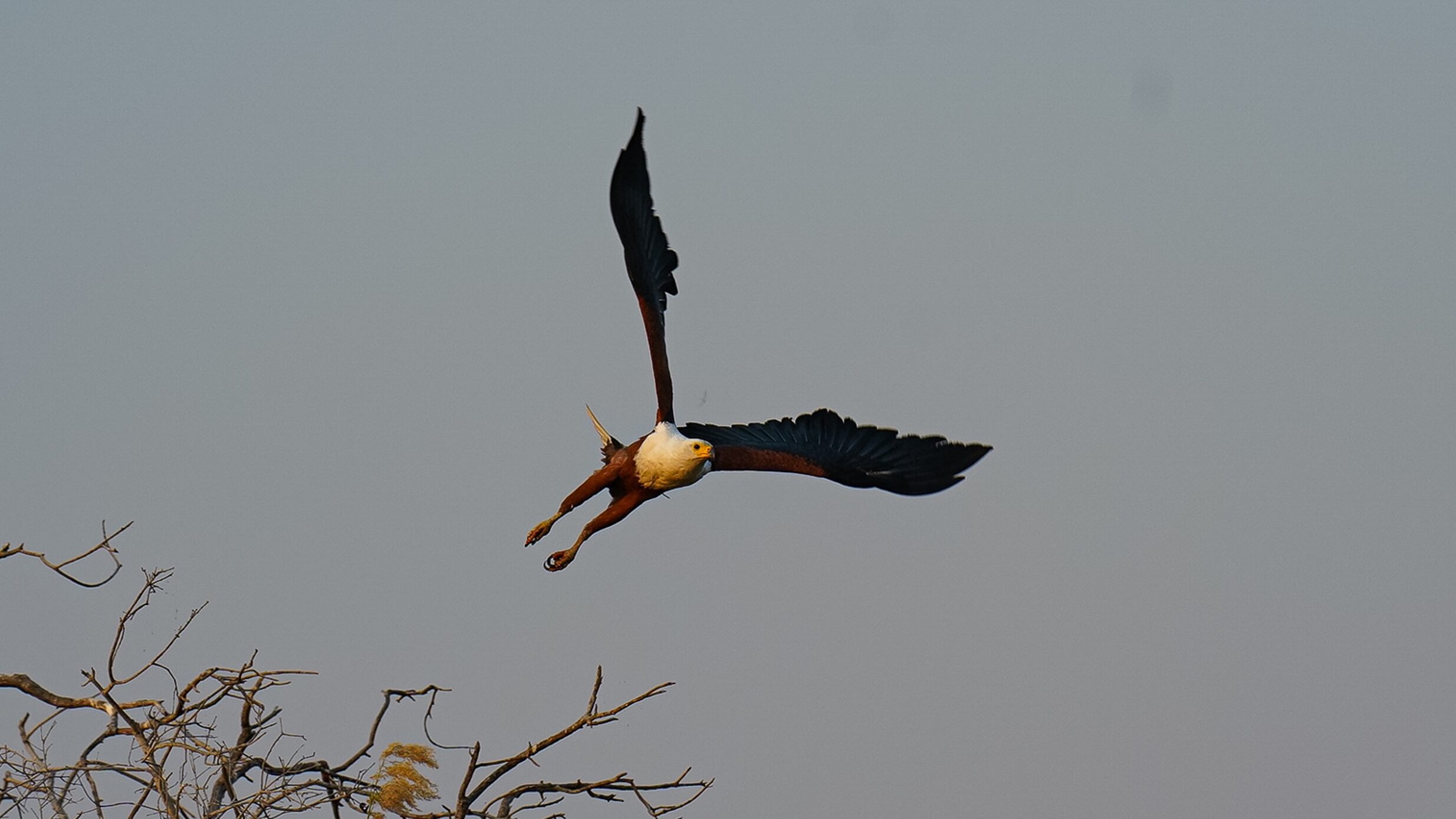
But what elevates this spectacle into a proper world-class feeding frenzy is why we are here. At the river’s edge, where the channel drops off to darker water, lurking unseen below are African tigerfish. For other fish, the tiger is a nightmare – an aggressive, powerful, manic, pack- oriented and extremely toothy predator. It is like a dagger-fanged piranha on growth hormones. For anglers, the tiger is a dream: they are built like striped bass, strike like bluefish, run like a bonefish and jump like tarpon.
As the barbel and birds maul the bulldogs and churchills in the reeds, the tigers rip in from the depths to pick off anything – baitfish, catfish, smaller tigers – that breaks out from the rodeo above. Present a fly or a crank bait into their No-Fly Zone when the barbel are feeding and the tigers will pounce, fangs bared.
“Jesus it’s like the zombie apocalypse” says Jonnie.
This being the first hour and my first cast of our fishing expedition, I strip line to the deck with a vigor proportionate to the adrenaline pumping into my bloodstream. As the vanguard of the barbel apocalypse churns into the papyrus wall directly in front of us, I begin my cast. I am targeting the narrow ribbon of water just three to six feet from the shoreline. A cast too close will likely hook you a fine catfish – fun maybe one time – but it’s not our target. And Way-Too- Close lands your fly in the reeds, after which you must sit out the blitz in progress while your buddy continues to fish. In the Angler’s Penalty Box, you wait until this run is over. Only then will System maneuver the skiff to the edge so we can retrieve a snagged fly or lure.
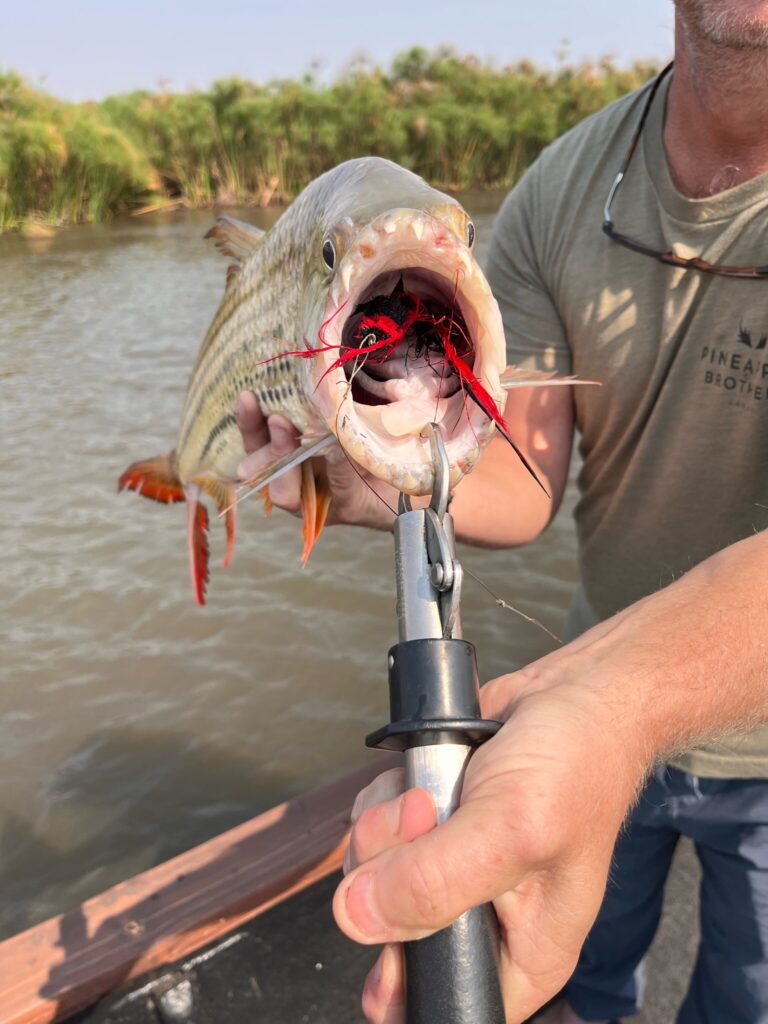
It is a specific-distance cast that is required – not too close, not too far. Landing the fly in the sweet spot, I strip the deceiver across the current where it sinks and swings. I cast and recast as quickly and controlled as my excitement will allow. As the barbel train continues to rumble past I feel my opportunity receding on this run. Strip, strip, strip…
The take is unmistakably ferocious. My nine-weight saltwater rod doubles over in an instant and then torques viciously, pulled by a primal force into deeper water. The sound of a sizzling drag is like the trumpeting of angels as the rapture takes hold. Endorphins flood my brain.
The rod torques one way and then another. I quickly reel in slack line as the fish comes back to the boat, and then up – airborne – presenting tiger fury in full view. It is a blur of gold, silver, red, black and…teeth. Convulsing with rage, the tiger splashes down and ramps up for another run and jump, then another. I sense I’m winning when we come to a standstill: tip up, rod bent, line tight, tiger tamed. The tension suddenly evaporates and like a phantom the tiger is gone. Unhooked. Lost.
These are the fish that get away. You might as well try to set your hook into a cast iron pan as a tiger’s bone-hard mouth and its picket of spiked teeth. The internet literature I read suggested I’d land one fish in 10 strikes. Knowing that does not make losing a great fish feel any better, but my self-pity is rudely interrupted.
“TIGER!” exclaims Jonnie.
She smartly resumed casting the instant she saw my line go slack. All of five feet zero inches tall, Jonnie fights to keep possession of her rod as the tiger bangs left, right, down, and finally up, clearing the water, shuddering furiously. Unable to shake the crankbait’s treble hook, the tiger gives her two more defiant jumps before losing power. Jonnie brings the exhausted fighter to the boat, System carefully nets it and admonishes us to “watch the teeth.”
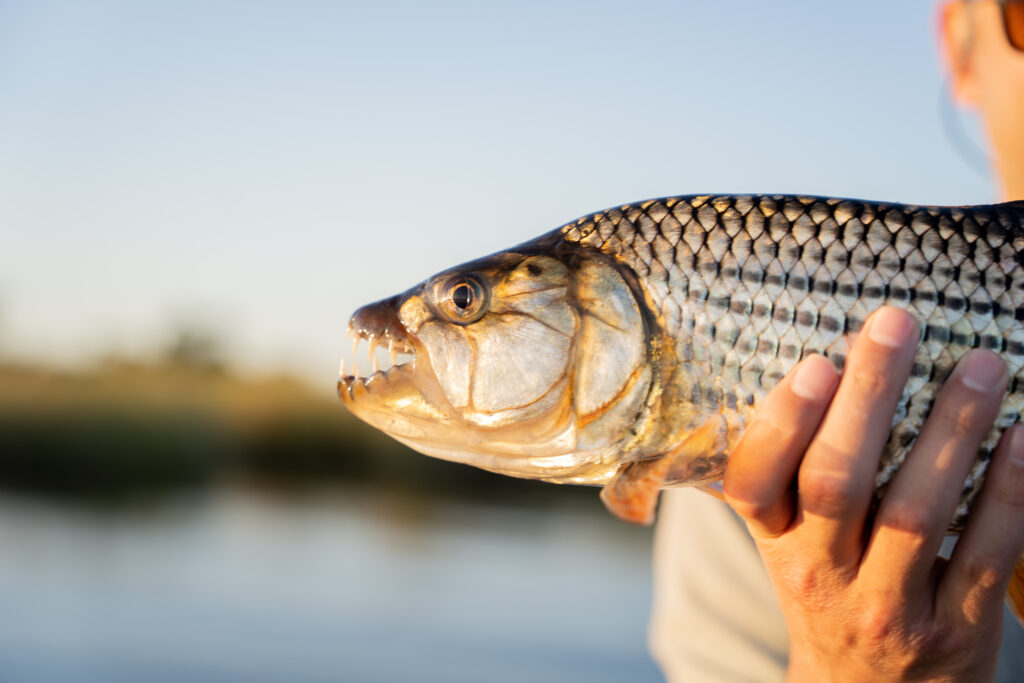
Watch we do. In the bright sun the tiger reflects the color of the ancient elements, gold, silver, brass and garnet. It is not done yet, slapping the deck, teeth bared, lunging for System’s hand as he manipulates the hook removal. The stoke is high as we admire its ballistic form and black stripes, which run the length of the muscular body, starting near the gaping mouth studded with protruding fangs. The stripes run past the orange tinted dorsal and anal fins, ending at the bright red, wide-forked tail that resembles a bluefin tuna’s. These fish are not the “goliaths” of big lakes and broad rivers elsewhere; Okavango River tigers are built for speed and violence.
The accelerative strength embodied in that red tail says everything you need to know about the tiger’s position at the top of this river’s food chain.
After Jonnie gets a quick photo with her fish, System revives and releases it. God help the next baitfish that angry killer sees.
Over the next three hours of our first afternoon we would find and fish several more barbel runs. I would connect on several more tigers, only to fail to set the hook and lose them all after short fights. As my frustration boiled and my will to win blew past Mach 5, I overpowered my fly into the papyrus and had to sit in the Angler’s Penalty Box on a couple of runs.
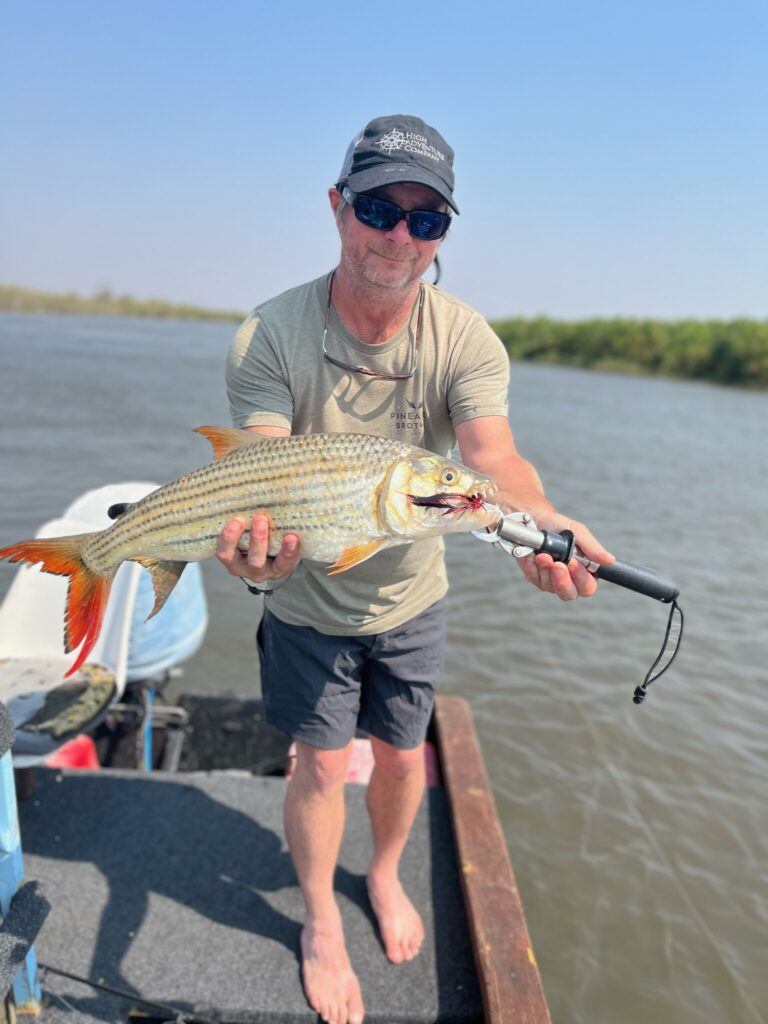
Nothing worked for me that afternoon, not switching flies and leaders, not sharpening and resharpening hooks, not cursing and bitching. My self-loathing was amplified by the good fortune of my wife, who landed two more tigers as well as some impressive, long-whiskered barbel. Hearing John and Tania cry “Tiger!” and “Fish on!” from their nearby skiff, at least I knew somebody in this world was landing tigers on the fly – just not me.
“I lost a couple too,” encouraged John over whiskeys that evening, carrying on the time-honored tradition of successful anglers comforting losers. “Buddy, that’s why they call it fishing.”
John Burrell, the founder and CEO of High Adventure Company knows fishing. He has spanned the globe exploring the world’s most exciting fisheries, and has caught more than enough species for a two-volume bucket list. He is here in Botswana developing the next essential fishing destination for itinerant anglers. I have fished my share of special places in the world, and when John invited me to join him I emphatically accepted. It didn’t matter that I had no idea what a tigerfish was or where it swam. I for sure did not know what the hell was involved in a barbel migration.
“Definitely a place to fish before you die, brother. The Okavango River barbel run is a natural spectacle,” John said. “Fighting these tigers on a fly rod, that’s as good as it gets on light tackle. This spot is going to be the Next Big Thing, you watch.”
The Next Big Thing is centered around the Nxamaseri Lodge, which started as a fly fishing outpost on this river over 40 years ago. It is a short bush plane flight from Maun, the gateway city to the Okavango Delta. As long as there are no cattle, wild burros, or elephants loitering on the dirt air strip, it’s a quick ride from there to the water, where a skiff hauls you and your tackle a few minutes to the boat launch fronting the lodge.
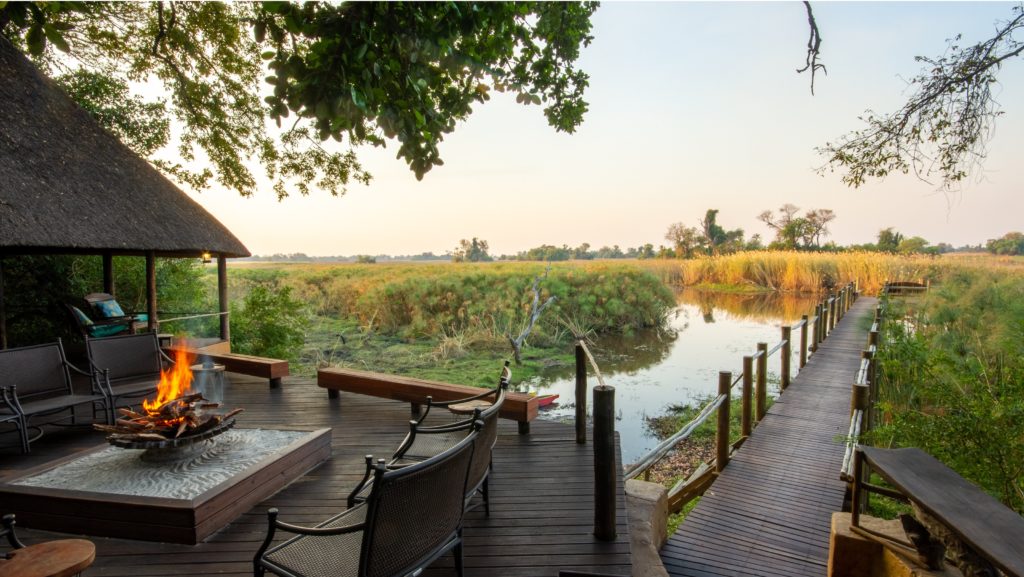
Isolated and nested in riverine vegetation and leafy jackalberry trees on the channel, with no roads leading in or out, the boutique-size Nxamaseri is not a place where you’ll rough it. The rooms, the dining and bar pavilion, swimming pool, fire pit, and the riverfront deck are simple, classy and comfortable. The food and service are first-rate. The guests – mostly birders and anglers – are great company.
Most importantly, the fishing guides are the masters of this realm. Mr. P, the chief guide, is known throughout the delta as a leading authority on this fishery. System was a perfect match for Jonnie and me. He is a man of few words, deep experience, and an endless reserve of generous patience. He quietly and without fail put us on fish, helped with tackle and fly changes, and managed the landing, revival and release of our catch.
The next morning my optimism swelled with the sunrise. Local fishermen standing in ebony mokoro canoes wish me luck as we motor by. They are staging for a full day of subsistence fishing with long cane poles, tied lines, and bottle cap jigs. 10 hours from now they will have a full string or more of barbel, bream, tilapia, and maybe even a tiger.
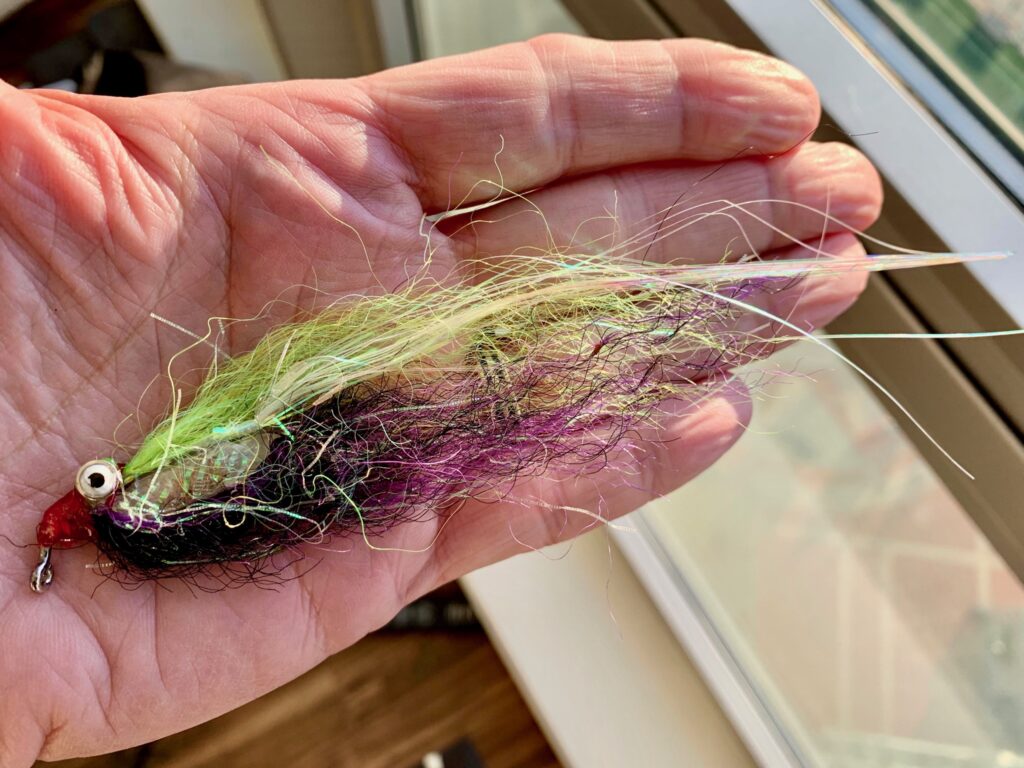
On John’s advice to go big, I tied on a fly completely different than what the internet suggested. My California brother-in-law Marty gifted me with an Adachi Rattle Clouser, a West Coast design involving five inches of chartreuse, purple and black fiber, red gills, a rattle, tutti- frutti tail flash, and barbell eyes tied on a 3/0 jig hook. The Adachi might be ignored but it would not go unnoticed. The hook was filed to katana sharpness. The leader terminated in fresh piano wire. My attitude smoldered with the eye of the tiger.
“Let me not then die ingloriously and without a struggle, but let me first do some great thing that shall be told among men hereafter.”
My path to glory was not as doomed as Hector’s, but I squared up to the birds and the barbel and the tigers just as he did with Achilles at Troy.
Four hours later, glory was mine…
For the exciting finish to this article and more like it, subscribe to The Sporting Life at the link below!
